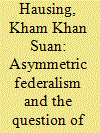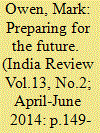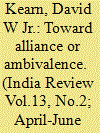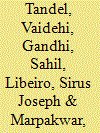| Srl | Item |
| 1 |
ID:
132077


|
|
|
|
|
| Publication |
2014.
|
| Summary/Abstract |
This article intends to fill a glaring void in the existing academic literature on the issues and challenges which stem not only from crafting, but also making asymmetric federalism work in northeast India. It examines the extent and limits to which asymmetric federalism-specifically under Article 371A of India's Constitution-not only negotiates Nagas' sovereignty claims over their land and resources and caters to the demands of democratic justice, but also the extent to which it consolidates India's state-nation and democracy building in its northeastern periphery. Contending that the extant asymmetric federal arrangement in India's polity stems from a centralist federal framework, the article makes a case for a more robust asymmetric federalism, which goes beyond this framework.
|
|
|
|
|
|
|
|
|
|
|
|
|
|
|
|
| 2 |
ID:
132080


|
|
|
|
|
| Publication |
2014.
|
| Summary/Abstract |
In his 1997 analysis of the history of Tibetan and Chinese relations (The Snow Lion and the Dragon), Melvyn Goldstein advised in his concluding chapter that Tibetans were unlikely to indefinitely put up with the Chinese occupation of Tibet without resorting to violence. However, despite continuing speculation, more widespread or sustained campaigns of violence have largely failed to materialize. The principle objectives of this study are to establish why the scale of violence that Goldstein warned about has so far failed to emerge; and to assess whether existing evidence supports or undermines claims that violence may in the future emanate from Tibetan exile communities in India. It will be argued that previous analyses have been premised on a relatively narrow assessment of the situation and context, and that a more informed and nuanced evaluation of the potential for future violence requires comprehensive analysis of a much wider range of factors.
|
|
|
|
|
|
|
|
|
|
|
|
|
|
|
|
| 3 |
ID:
132079


|
|
|
|
|
| Publication |
2014.
|
| Summary/Abstract |
Utilizing prevailing International Relations theory, this article seeks to explain the conditions under which India and the United States can be expected to achieve deep, long-term, strategic cooperation that could culminate in a formal alliance. Specifically, it considers the insights and predictions of realist and liberal theories while also considering critical domestic level factors that may shape India's capacity to be a reliable and attractive partner. While dramatic progress has been made since the initial thawing of the Cold War relationship, this article concludes that the future is likely to be a mixed bag, as the recent Obama experience has reflected. Only the emergence of an overtly revisionist China is likely to drive New Delhi and Washington toward a traditional alliance.
|
|
|
|
|
|
|
|
|
|
|
|
|
|
|
|
| 4 |
ID:
132078


|
|
|
|
|
| Publication |
2014.
|
| Summary/Abstract |
In developing countries, separation of powers coexists with corruption by the ruling elite. This can be attributed to informal institutions, which counter the formal checks and balances. We demonstrate, by studying the Adarsh scam, the vulnerabilities of checks and balances. Fourteen actors belonging to different tiers of the Indian federal setup who could have vetoed the project or certain permissions failed to do so.We find that 54 percent of the checks collapsed because of quid pro quo, 21 percent due to being overridden, 4 percent due to misrepresentation, 7 percent due to absorption, and 14 percent due to omissions in the process.
|
|
|
|
|
|
|
|
|
|
|
|
|
|
|
|